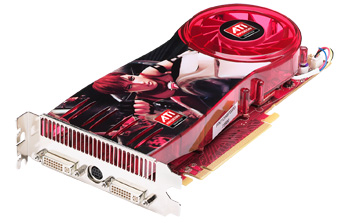Radeon HD 3870
Radeon HD 3870 is the top-end launch SKU, and the first thing you'll notice is a lack of XT, PRO or other suffixes when it comes to delineating the product stack. The last two digits now do that job, with the first marking out the generation and the second digit telling you the family. If you want to match new to old, 70 is what would likely have been an XT, and 50 is what would likely have been a PRO. Got it? Good stuff.
So HD 3870 pairs a full RV670 at 775MHz with 512MiB of GDDR4 at over 1.13GHz (2.26GHz effective clock). So you've got a large framebuffer, as big as you do with Radeon HD 2900 XT, with high speed devices to offset the bus width deficit as much as possible, which means that HD 3870 likely has most of the match of HD 2900 XT if not bandwidth bound.
We should mention that we think there are _some_ GPU-level improvements in RV670 compared to R600 that should make it overall faster per-clock when not memory bound, centered around use of the cache hierarchies and the resolve of multisamples. We've not got enough data to say that conclusively yet, though. Anyhow, any performance improvement is likely to originate from increases in efficiency, with unit counts and so forth remaining completely unchanged.
The most interesting part of this HD 2900 XT-matcher is arguably not in the raw numbers and on-paper performance, but in its physical properties. HD 2900 XT's cooler is a noisy thing, designed to keep a hot-running GPU on the right side of its thermal limit. RV670 has less than half the peak TDP of R600, and due to power-saving technologies and some new demand-based configuration, it's probably even less than half the power usage on average when playing games. That's for what's roughly the same real-world performance remember.
It's a dual-slot cooler strapped to the diminutive chip and cool-running memories, but it's more overkill than needed in our opinion. We get the impression that early power estimates for RV670 under load were somewhere less than the measured reality when the chip came back and was tested. They had contingency for a heat output that required two slots worth of thermal equipment to keep it cool. That now buys them a tradeoff back in the direction of silence, and HD 3870 boards with the pictured cooler should be much quieter than the GeForce 8800 GT we've been kicking around B3D Towers in the last couple of weeks.
All HD 3870s will support HDMI output via an active dongle connected to either of the fully dual-link, HDCP-protected (on both links) DVI outputs, which the UVD block will do its best to feed with decoded hi-def video. In terms of video-to-3D-to-price performance, HD 3870 should be hands down the most competent product yet seen, because of RV670 and what it's got on the silicon.
There's not much more to say, other than we're dying to test it versus not just GeForce 8800 GT, but versus all manner of SKUs from NVIDIA and AMD's own stable. More about performance later on.

